Potential for Building Façade-Integrated Solar Thermal Collectors in a Highly Urbanized Context
Abstract
1. Introduction
Objective
2. Technologies for Collectors’ Integration
Customization
Roof Integration
Façade Integration
Shading Element on Facade
Substitution of Frames and Balustrades
The Assessment of Integration Level
- The climatic and urban planning criteria (global solar irradiance greater than 1500 kWh/m2, at least two roofs or two facades with favorable orientation)—From an energetic point of view, the energy produced will be proportional to the portion of the envelope available. The problem has different perspectives depending on whether it is a new construction (the expected energy needs require the available surfaces) or an energy retrofit (the available surface limits the amount of energy produced) [35,36]. Finally, placing solar thermal panels on periodically shaded surfaces of the building envelope could result in a lower system efficiency and cause damage from thermal stress resulting in glass cracks.
- Functional criteria—DHW systems electric-powered or centralized are better suited for integration with STC. The vacuum tube collectors are more efficient than the flat collectors but require greater system complication. Careful planning of the spaces intended for the storage tanks is required. The latter is a twofold problem, having to take into account that the STCs must be sized both according to the energy demand and also to the total storage capacity available in order to avoid damage resulting from overheating.
- Architectural criteria—The need to exploit the entire available surface with solar collectors, or to use dummy elements to ensure uniformity to the building appearance, generally requires the development of a specific and expensive customized product [36,37]. Reflections from the glass cover can cause undesirable glare. It must be borne in mind that its intrinsic characteristic of “transparency” can make visible the part responsible for absorbing solar energy, usually characterized by a sheet of copper, aluminum, or steel metal in a single piece or consisting of a row of metal strips. This problem is also present in vacuum tubes where both the absorbent metal strip inside and the rear reflective plates are always visible. “transparency” can make visible the part responsible for absorbing solar energy, usually characterized by a sheet of copper, aluminum, or steel metal in a single piece or consisting of a row of metal strips. This problem is also present in vacuum tubes, where both the absorbent metal strip inside and the rear reflective plates are always visible [37,38]. To date, the set of evaluation criteria proposed by Krstic remains the best attempt to standardize the level of architectural integration of solar systems.
3. Materials and Methods
The Potential Energetic Production in Urban Contexts
- -
- 19÷ 22%, respectively for HP and GL collectors and 45° installation;
- -
- 13÷ 17%, respectively for HP and GL collectors and 90° installation.
The Case Study
4. Results and Discussion
5. Conclusions
Author Contributions
Funding
Conflicts of Interest
References
- Hestnes, A.G. Building integration of solar energy systems. Sol. Energy 1999, 67, 181–187. [Google Scholar] [CrossRef]
- Voss, K. Solar energy in building renovation—Results and experience of international demonstration buildings. Energy Build. 2000, 32, 291–302. [Google Scholar] [CrossRef]
- Munari Probst, M.C.; Roecker, C. Towards an improved architectural quality of building integrated solar thermal systems (BIST). Sol. Energy 2007, 81, 1104–11169. [Google Scholar] [CrossRef]
- Arpino, F.; Cortellessa, G.; Frattolillo, A. Experimental and numerical assessment of photovoltaic collectors performance dependence on frame size and installation technique. Sol. Energy 2015, 118, 7–19. [Google Scholar] [CrossRef]
- Reinberg, G.W. Architetture; Alinea: Florence, Italy, 1999. [Google Scholar]
- IEA. Advanced Solar Domestic Hot Water System; Report of Task 14; IEA: Paris, France, 1996. [Google Scholar]
- IEA. Solar Energy in Building Renovation; Report of Task 20; IEA: Paris, France, 1998. [Google Scholar]
- IEA. Optimization of Solar Energy Use in Large Buildings; Report of Task 23; IEA: Paris, France, 2000. [Google Scholar]
- Buker, M.S.; Riffat, S.B. Building integrated solar thermal collectors—A review. Renew. Sustain. Energy Rev. 2015, 51, 327–346. [Google Scholar] [CrossRef]
- Bock, M. A building integrated solar thermal collector with active steel skins. Energy Build. 2019, 201, 134–147. [Google Scholar] [CrossRef]
- Krstic Furundzica, A.; Kosoricb, V.; Golicc, K. Potential for reduction of CO2 emissions by integration of solar water heating systems on student dormitories through building refurbishment. Sustain. Cities Soc. 2012, 2, 50–62. [Google Scholar] [CrossRef]
- Protection of Natural Beauty, Italian Law of 29 June 1939, n. 1497. Off. Ital. Gazzette 2004, 45. Available online: https://www.gazzettaufficiale.it/eli/gu/2004/02/24/45/so/28/sg/pdf (accessed on 23 October 2020).
- European Council. Directive 2010/31/EU of the European Parliament and of the Council of 19 May 2010 on the energy performance of buildings. Off. J. Eur. Union 2010, 153, 13–35. [Google Scholar]
- European Union. Directive 2012/27/EU of the European Parliament and of the Council of 25 October 2012 on energy efficiency, amending Directives 2009/125/EC and 2010/30/EU and repealing Directives 2004/8/EC and 2006/32/EC. Off. J. Eur. Communities OJL 2012, 315, 1–56. [Google Scholar]
- European Community. Directive (EU) 2018/844 of the European Parliament and of the Council of 30 May 2018 amending Directive 2010/31/EU on the energy performance of buildings and Directive 2012/27/EU on energy efficiency. Off. J. Eur. Union 2018, 156, 75–91. [Google Scholar]
- Transposition of the European Directive 2009/28/EC on the Promotion of the Use of Energy from Renewable Sources; Italian Legislative Decree 28/2011. Off. Ital. Gazzette 2011, 71. Available online: https://eur-lex.europa.eu/legal-content/EN/ALL/?uri=CELEX%3A32009L0028 (accessed on 23 October 2020).
- Code of Cultural Heritage and Landscape; Italian Legislative Decree, 22 January 2004, n. 42. Off. Ital. Gazzette 2004, 45. Available online: https://whc.unesco.org/document/155711 (accessed on 23 October 2020).
- Massimo, A.; Dell’Isola, M.; Frattolillo, A.; Ficco, G. Development of a geographical information system (GIS) for the integration of solar energy in the energy planning of a wide area. Sustainability 2014, 6, 5730–5744. [Google Scholar] [CrossRef]
- Buonomano, A.; Forzano, C.; Kalogirou, S.A.; Palombo, A. Building-façade integrated solar thermal collectors: Energy-economic performance and indoor comfort simulation model of a water based prototype for heating, cooling, and DHW production. Renew. Energy 2019, 137, 20–36. [Google Scholar] [CrossRef]
- Munari Probst, M.C.; Roecker, C. Criteria and policies to master the visual impact of solar systems in urban environments: The LESO-QSV method. Sol. Energy 2019, 184, 672–687. [Google Scholar] [CrossRef]
- Baccoli, R.; Frattolillo, A.; Mastino, C.; Curreli, S.; Ghiani, E. A comprehensive optimization model for flat solar collector coupled with a flat booster bottom reflector based on an exact finite length simulation model. Energy Convers. Manag. 2018, 164, 482–507. [Google Scholar] [CrossRef]
- Baird, G. The Architectural Expression of Environmental Control Systems; Spoon Press: London, UK; New York, NY, USA, 2001. [Google Scholar]
- Olgay, V. Design with Climate—A Bioclimatic Approach to Architectural Regionalism; University of Princeton Press: Princeton, NJ, USA, 1962. [Google Scholar]
- Kalogirou, A.S. Solar thermal collectors and applications. Prog. Energy Combust. Sci. 2004, 30, 231–295. [Google Scholar] [CrossRef]
- Tripanagnostopoulos, Y.; Souliotis, M.; Nousia, T. Solar collectors with coloured absorbers. Sol. Energy 2000, 68, 343–356. [Google Scholar] [CrossRef]
- Sun, X.Y.; Sun, X.D.; Li, X.G.; Wang, Z.Q.; He, J.; Wang, B.S. Performance and building integration of all-ceramic solar collectors. Energy Build. 2014, 75, 176–180. [Google Scholar] [CrossRef]
- Xu, J.; Yang, Y.; Cai, B.; Wang, Q.; Xiu, D. All-ceramic solar collector and all ceramic solar roof. J. Energy Inst. 2014, 87, 43–47. [Google Scholar] [CrossRef]
- O’Hegarty, R.; Kinnane, O.; McCormack, S.J. Review and analysis of solar thermal facades. Sol. Energy 2016, 135, 408–422. [Google Scholar] [CrossRef]
- Tsilingiris, P.T. Towards making solar water heating technology feasible—The polymer solar collector approach. Energy Convers. Manag. 1999, 40, 1237–1250. [Google Scholar] [CrossRef]
- D’Antoni, M.; Saro, O. Energy potential of a massive solar-thermal collector design in European climates. Sol. Energy 2013, 93, 195–208. [Google Scholar] [CrossRef]
- Baunetzwissen HomePage. Available online: https://www.baunetzwissen.de (accessed on 23 October 2020).
- Höchstleistung zu Jeder Jahreszeit. Available online: http://augusta-solar.com/hochleistungs-kollektoren (accessed on 23 October 2020).
- Schüler, A.; Boudaden, J.; Oelhafen, P.; De Chambrier, E.; Roecker, C.; Scartezzini, J.-L. Thin film multilayer design types for coloured glazed thermal solar collectors. Sol. Energy Mater. Sol. Cells 2005, 89, 219–231. [Google Scholar] [CrossRef]
- Dudita, M.; Manceriu, L.M.; Anastasescu, M.; Nicolescu, M.; Gartner, M.; Duta, A. Coloured TiO2 based glazing obtained by spray pyrolysis for solar thermal applications. Ceram. Int. 2014, 40, 3903–3911. [Google Scholar] [CrossRef]
- Visa, I.; Moldovan, M.; Comsit, M.; Neagoe, M.; Duta, A. Facades integrated solar-thermal collectors—Challenges and solutions. Energy Procedia 2017, 112, 176–185. [Google Scholar] [CrossRef]
- Lamnatou, C.; Cristofari, C.; Chemisana, D.; Canaletti, J.L. Building-integrated solar thermal systems based on vacuum-tube technology: Critical factors focusing on life-cycle environmental profile. Renew. Sustain. Energy Rev. 2016, 65, 1199–1215. [Google Scholar] [CrossRef]
- Prieto, A.; Knaack, U.; Auer, T.; Klein, T. Solar façades—Main barriers for widespread façade integration of solar technologies. J. Facade Des. Eng. 2017, 5, 51–62. [Google Scholar]
- Maurer, C.; Cappel, C.; Kuhn, T.E. Progress in building-integrated solar thermal systems. Sol. Energy 2017, 154, 158–186. [Google Scholar] [CrossRef]
- Cellura, M.; Guarino, F.; Longo, S.; Mistretta, M. Energy life-cycle approach in Net zero energy buildings balance: Operation and embodied energy of an Italian case study. Energy Build. 2014, 72, 371–381. [Google Scholar] [CrossRef]
- Energy Performance of Buildings—Method for Calculation of System Energy Requirements and System Efficiencies—Part 4–3: Heat Generation Systems, Thermal Solar and Photovoltaic Systems; UNI EN 15316-4-3:2018; Module M3-8-3, M8-8-3, M11-8-3; Italian Organization for Standardization: Milano, Italy, 2018.
- Appleyard, W.; Konkle, D. Making solar thermal fit in Ann Arbor’s 5000 solar roofs programme. Renew. Energy World 2007, 10, 80–86. [Google Scholar]
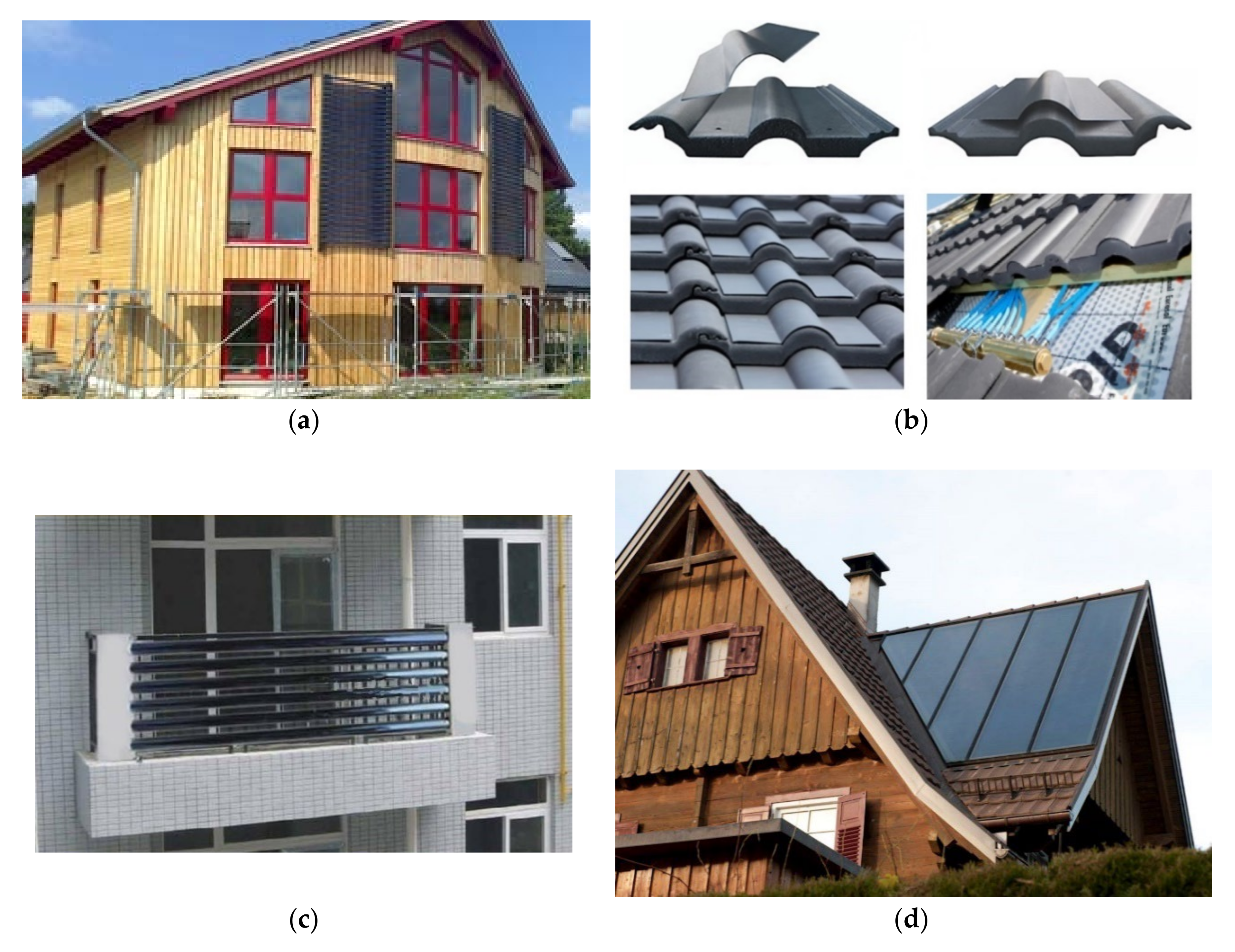

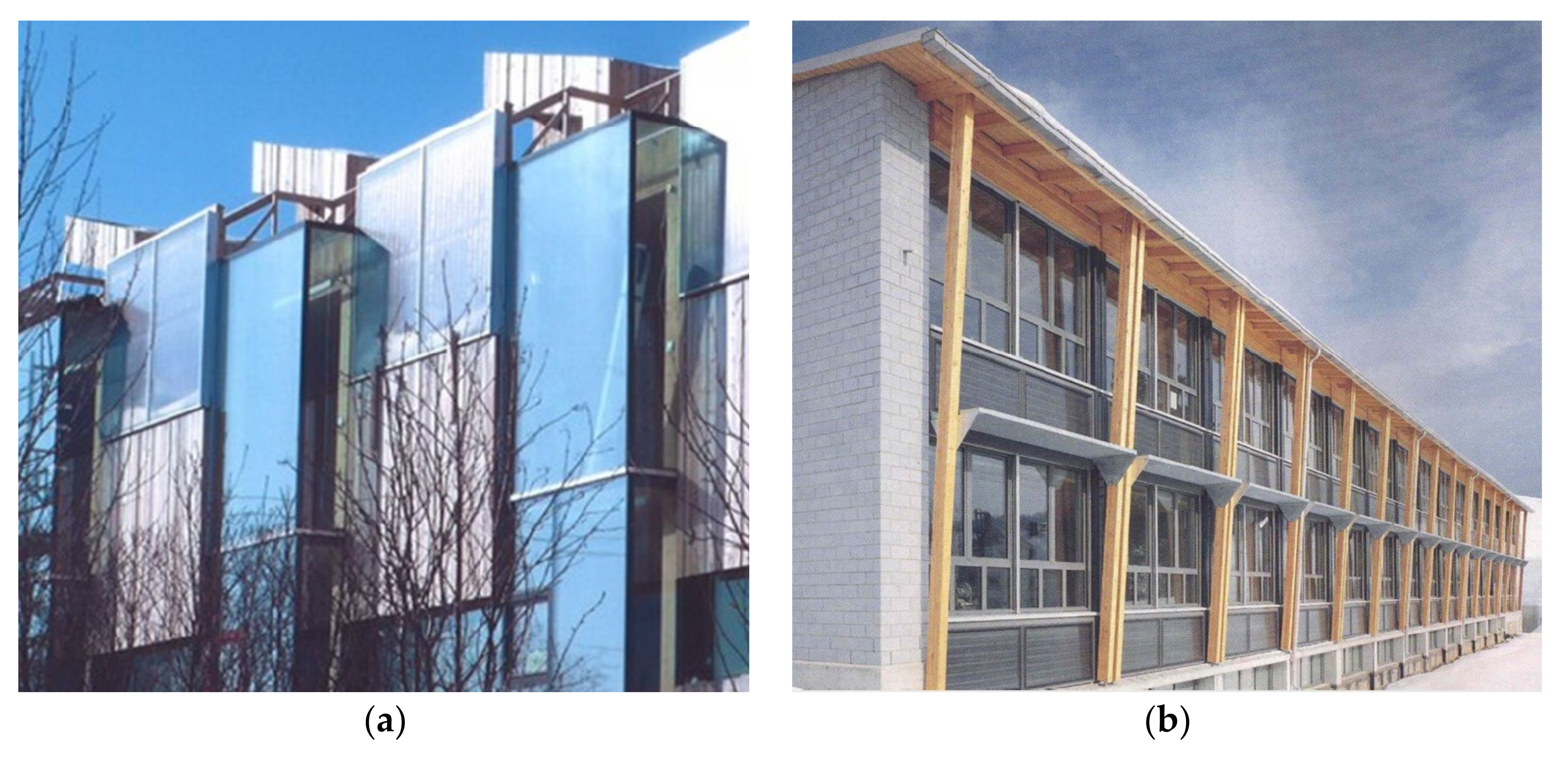
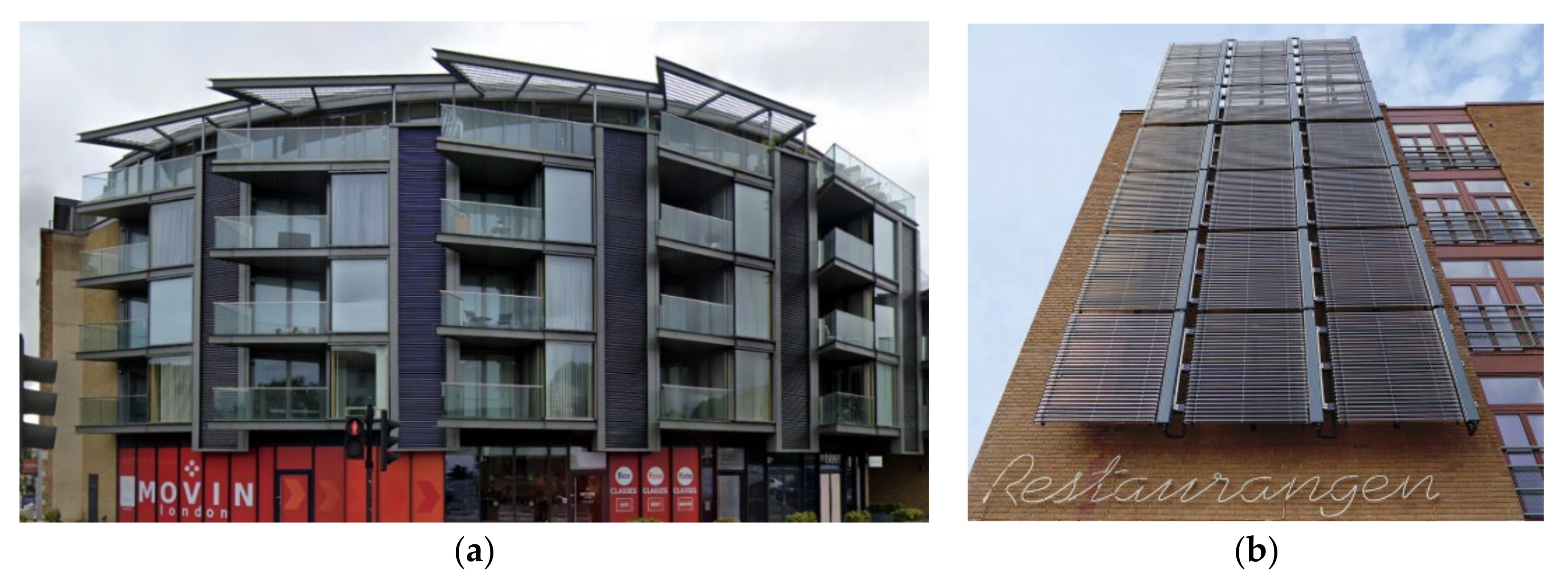
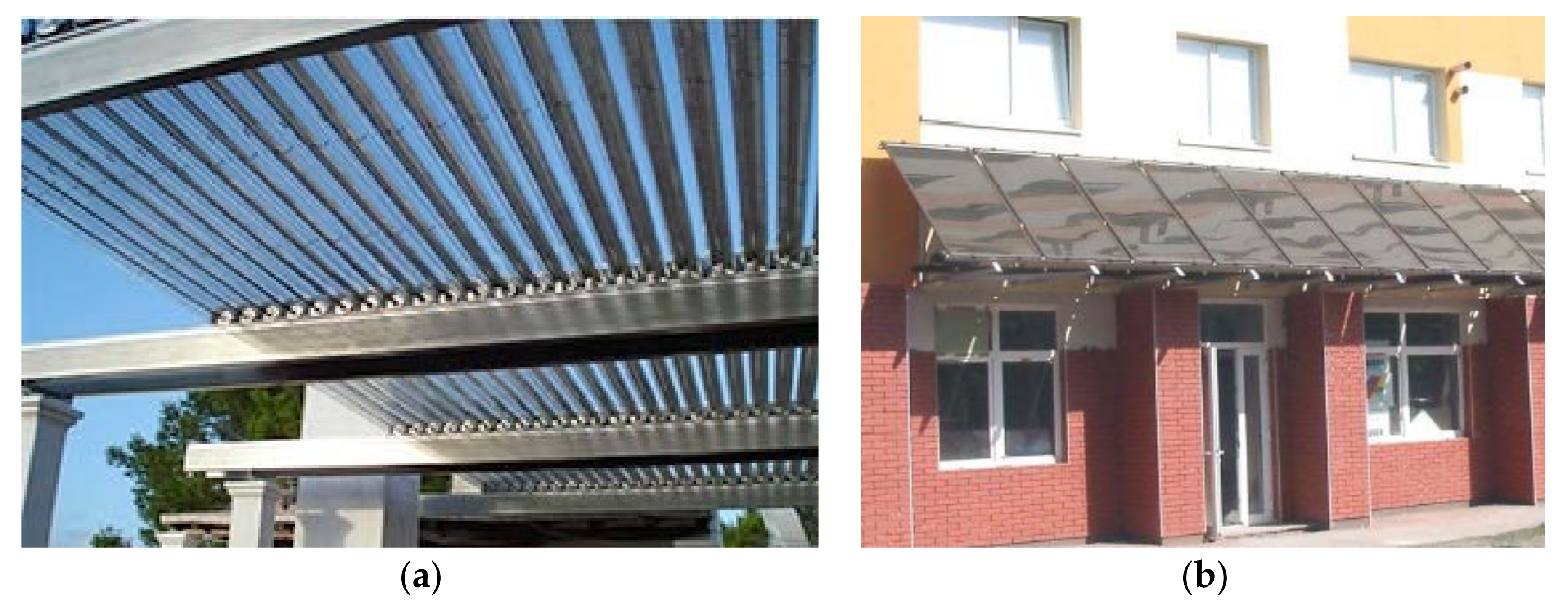
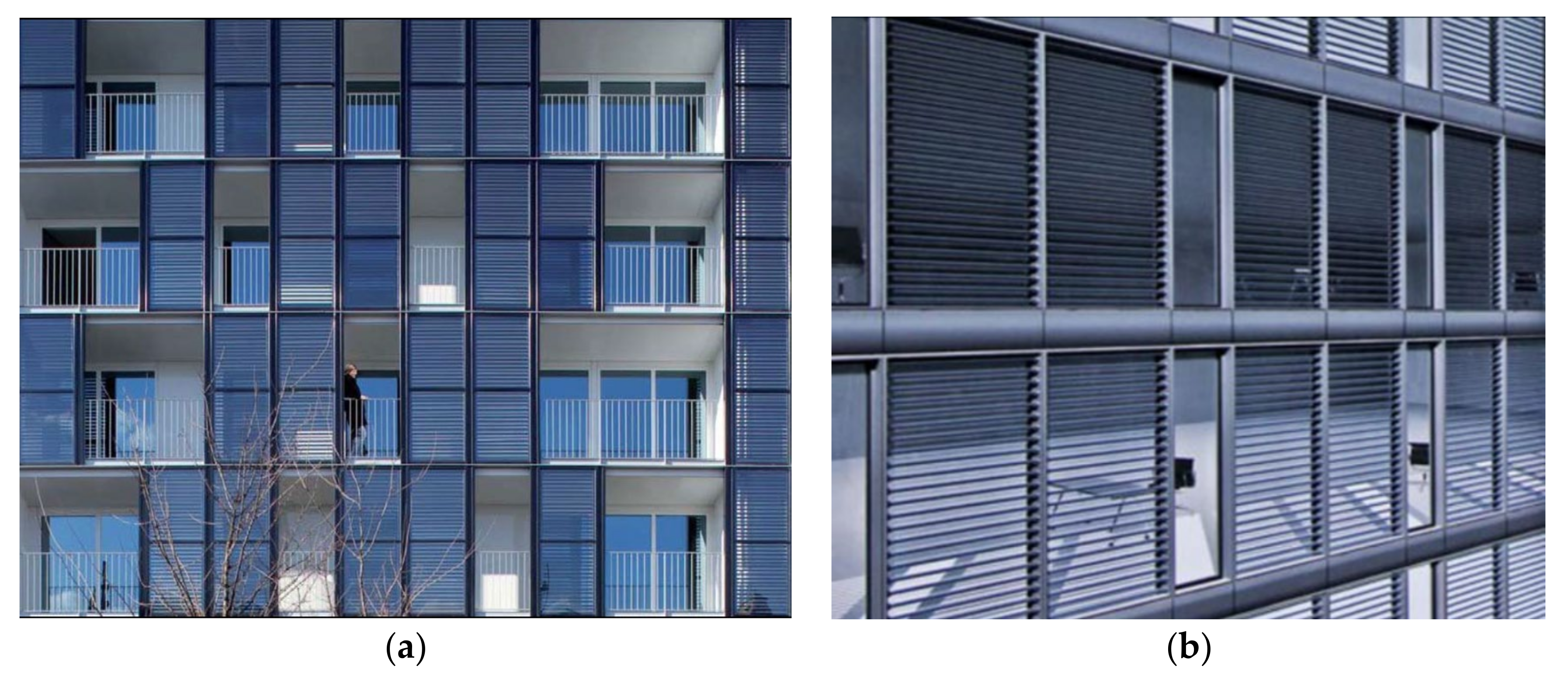
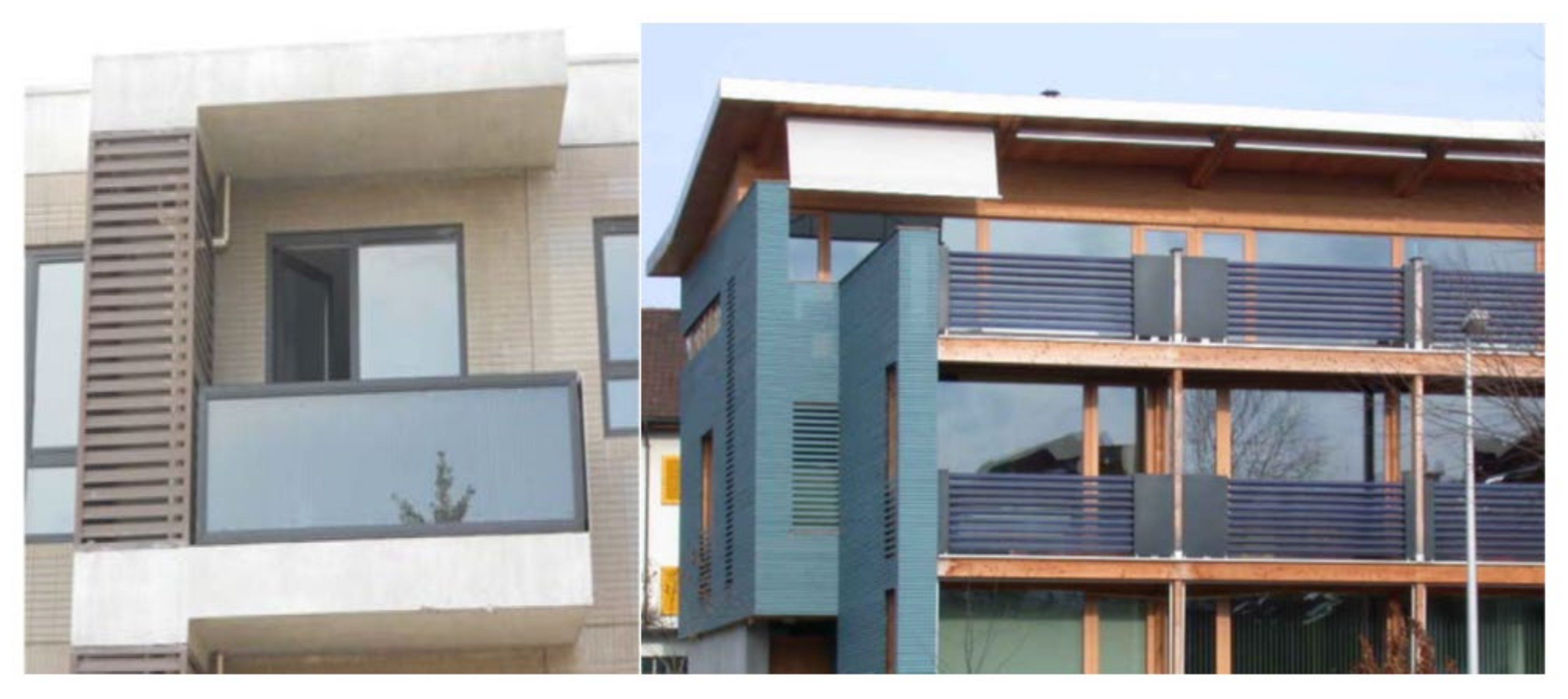
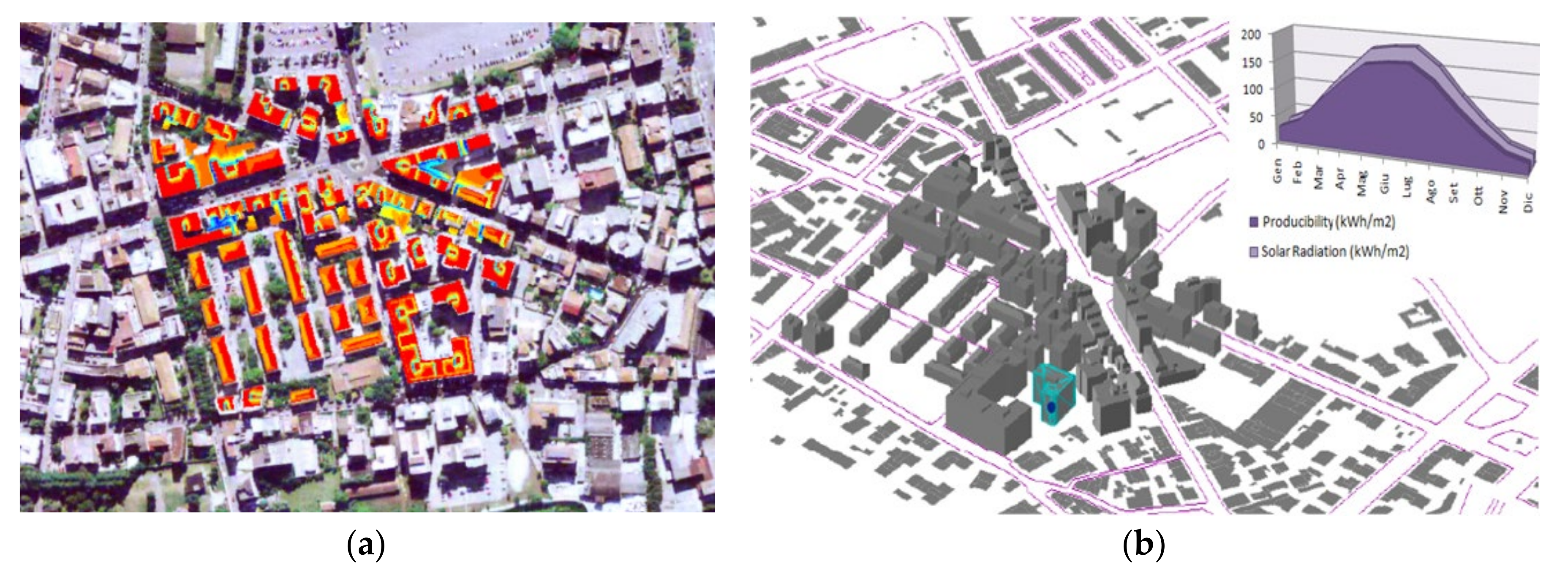
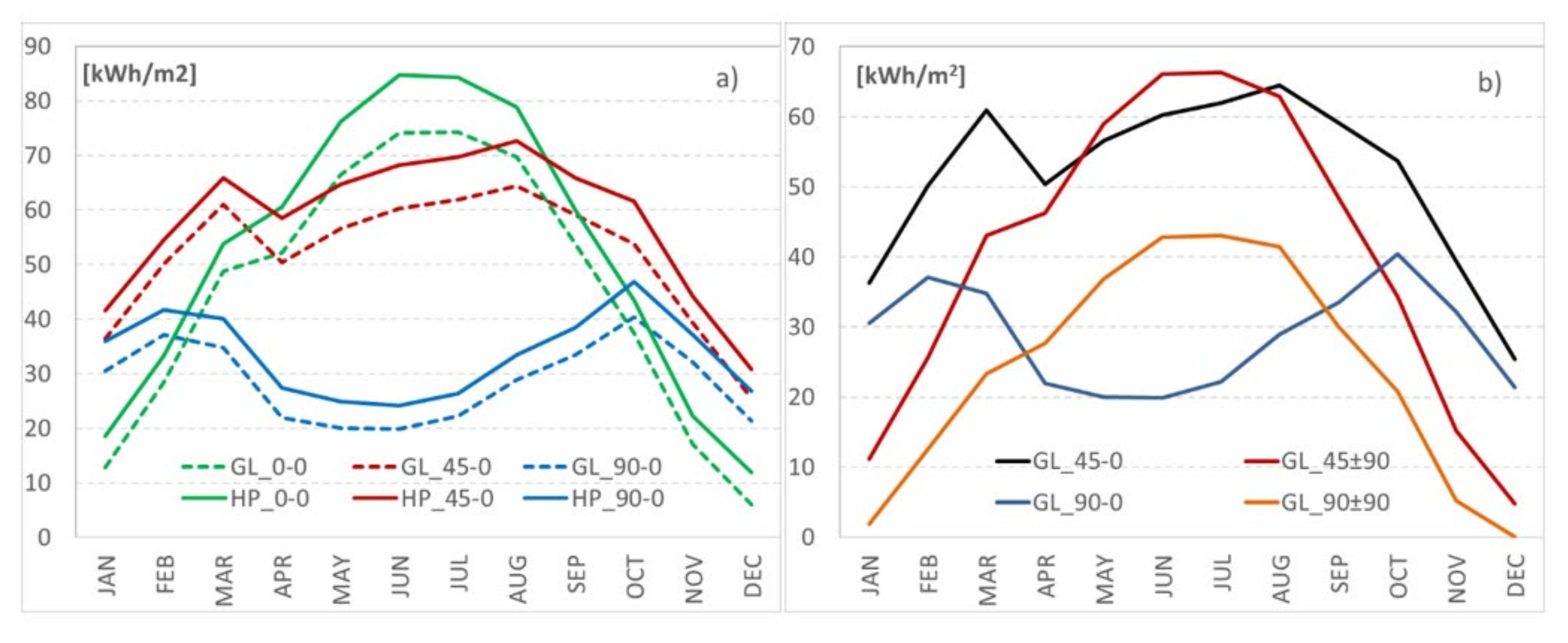
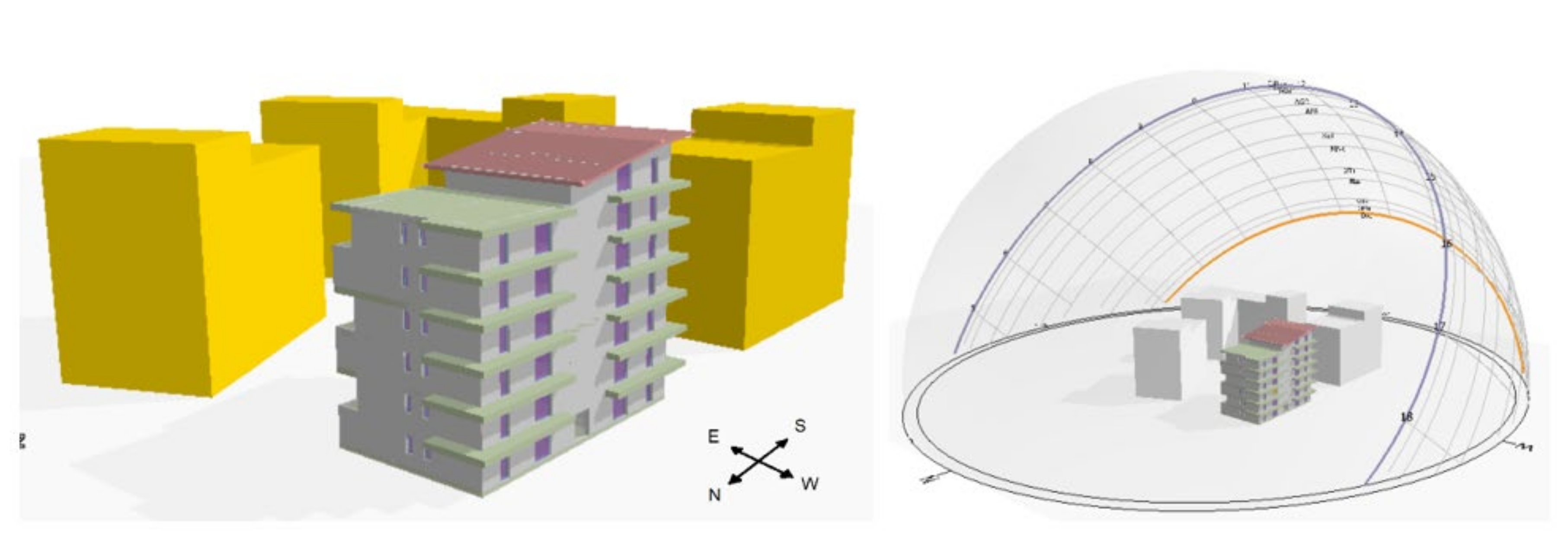
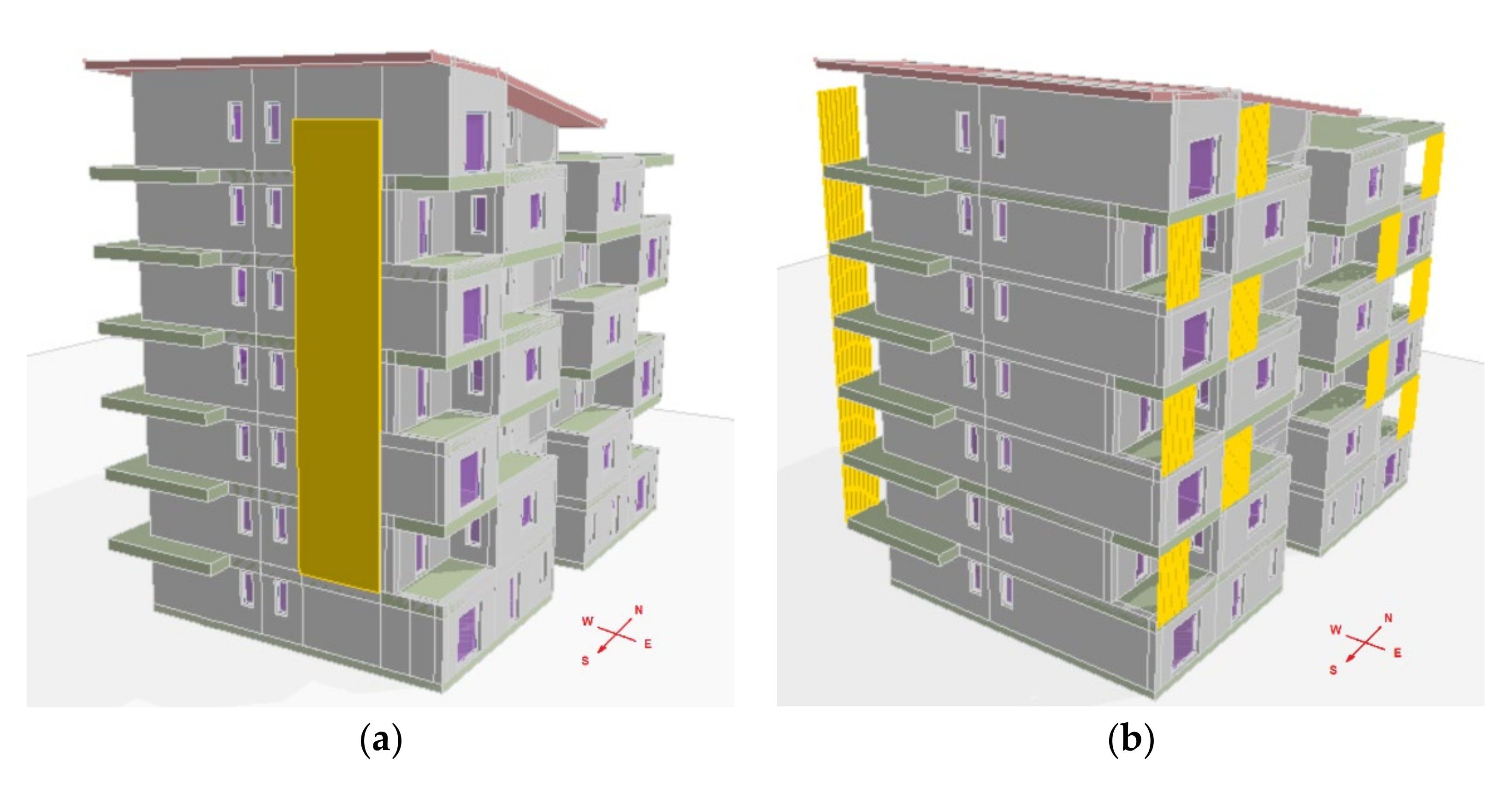
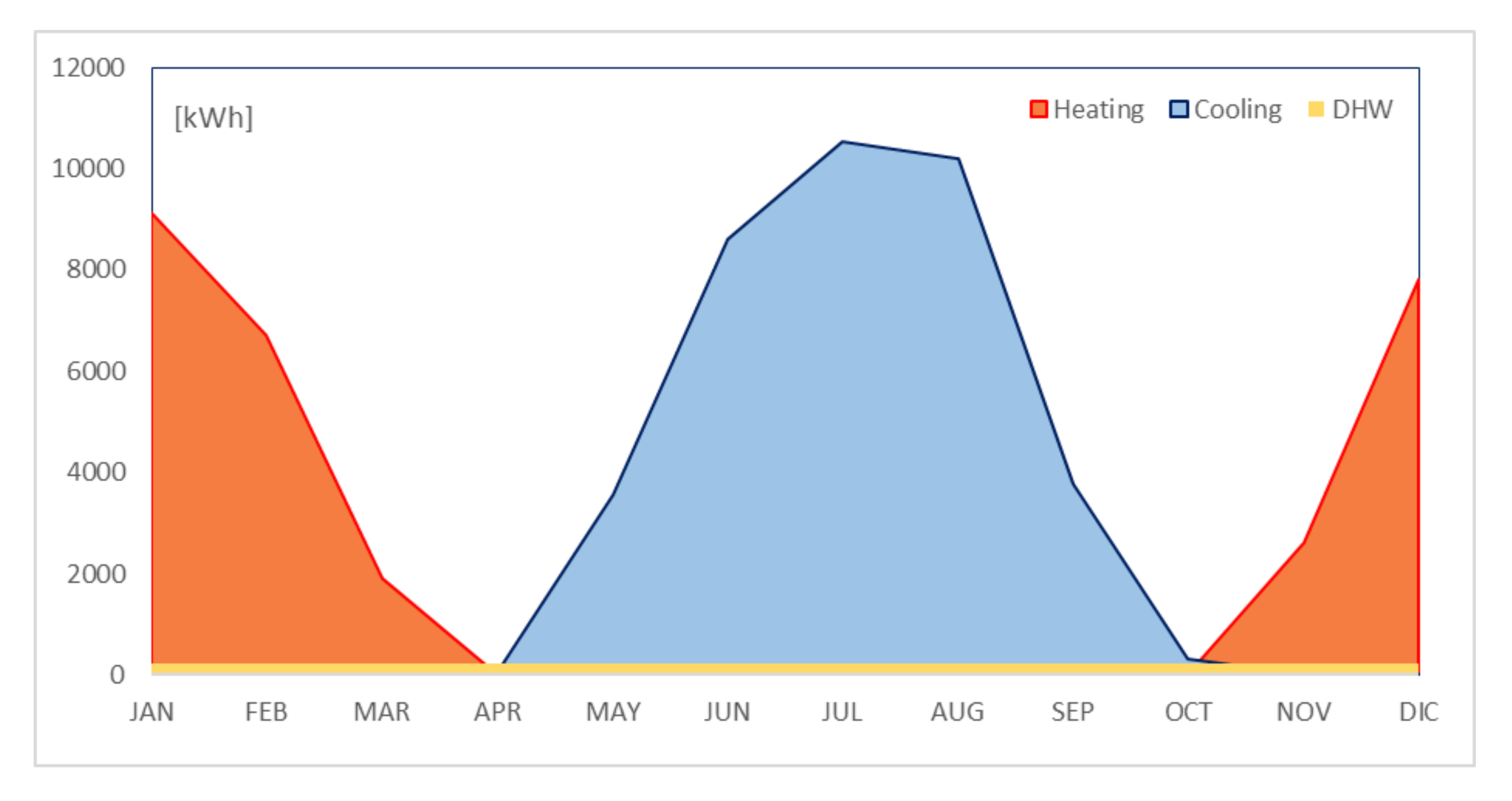
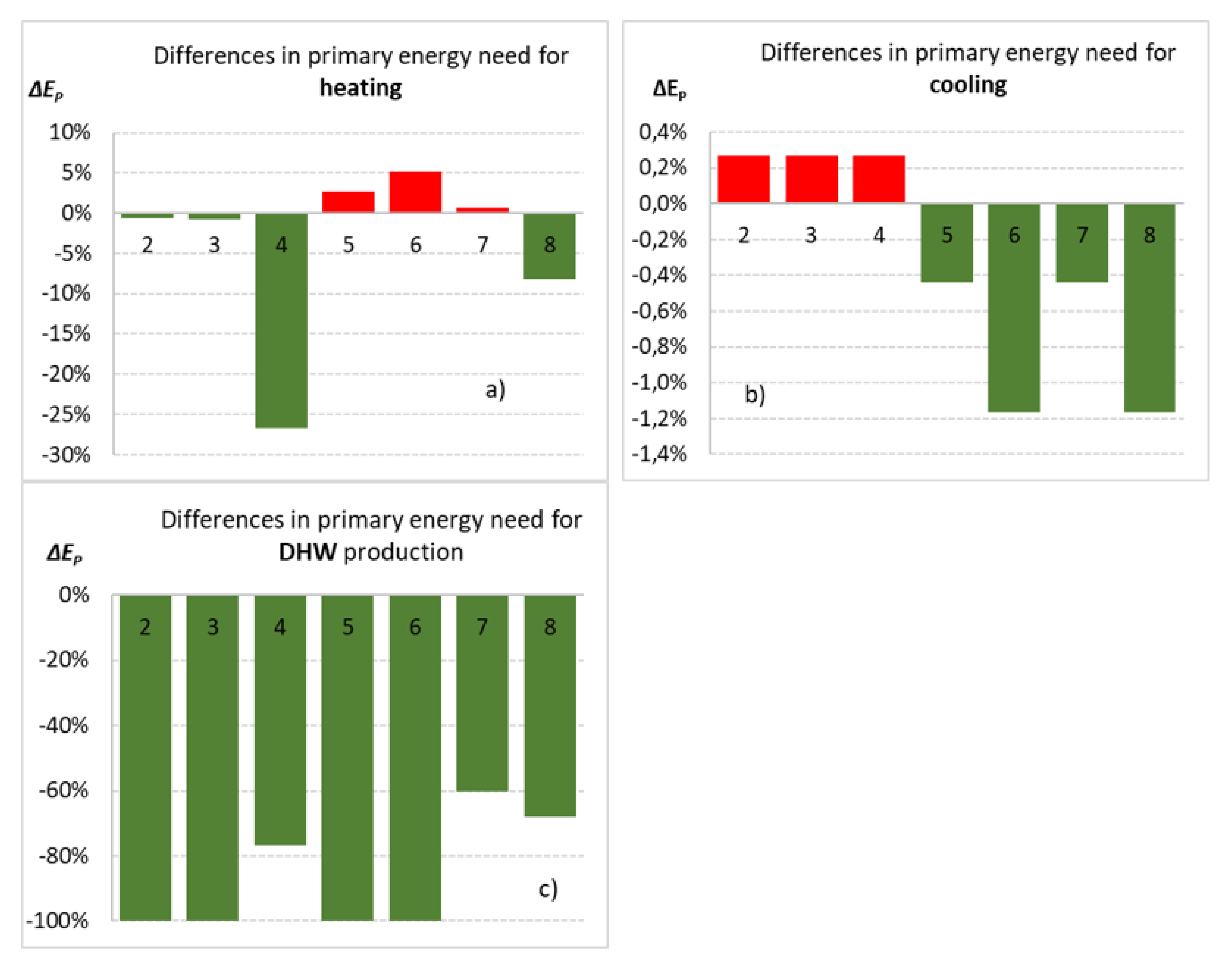
| Absorber Area | Optical Efficiency | |||
|---|---|---|---|---|
| Glazed collector GL | 2.32 m2 | 82.4% | 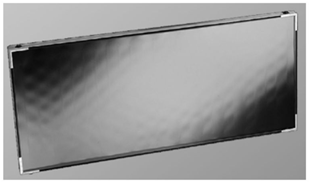 | Performances assessed according to the manufacturer’s specifications and the UNI-EN 15316-4-3 technical standard [40] |
| Evacuated tube collector HP | 1.63 m2 | 76% | 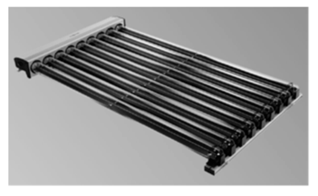 |
| Scenario | Integrated Solar System | Installation of STC | STC Service Purpose | Note |
|---|---|---|---|---|
| #1 | Reference scenario | Absent | --- | |
| #2 | Flat plate collectors | 22 on South façade | DHW | |
| #3 | 22 on West (or East) façade | DHW | Rotated ±90° | |
| #4 | 22 on South façade | Heating + DHW | ||
| #5 | Evacuated-tube solar collectors as “active” sun shading elements | 11 on East facade balconies | DHW | |
| #6 | 11 on East facade balconies + | DHW | ||
| 11 on West facade balconies | ||||
| #7 | 11 on East facade balconies | Heating + DHW | ||
| #8 | 11 on East facade balconies + | Heating + DHW | ||
| 11 on West facade balconies |
| Ref. | Jan | Feb | Mar | Apr | May | June | July | Aug | Sep | Oct | Nov | Dic | Tot. | % Diff |
|---|---|---|---|---|---|---|---|---|---|---|---|---|---|---|
| # 1 | 9140.8 | 6699.8 | 1920.6 | - | - | - | - | - | - | - | 2605.2 | 7804.6 | 28,171.0 | |
| # 2 | 9090.5 | 6653.7 | 1892.8 | - | - | - | - | - | - | - | 2586.2 | 7762.1 | 27,985.3 | −0.7% |
| # 3 | 8422.0 | 6523.8 | 2544.0 | - | - | - | - | - | - | - | 2289.4 | 7210.7 | 26,989.9 | −4.2% |
| # 4 | 7444.5 | 4705.4 | 565.7 | - | - | - | - | - | - | - | 1204.5 | 6717.7 | 20,637.7 | −26.7% |
| # 5 | 9342.3 | 6807.2 | 1990.5 | - | - | - | - | - | - | - | 2733.5 | 8033.8 | 28,907.4 | 2.6% |
| # 6 | 9537.2 | 6970.9 | 2108.5 | - | - | - | - | - | - | - | 2853.6 | 8177.3 | 29,647.6 | 5.2% |
| # 7 | 9381.7 | 6594.2 | 1564.6 | - | - | - | - | - | - | - | 2627.3 | 8177.3 | 28,345.1 | 0.6% |
| # 8 | 8916.8 | 6011.0 | 987.2 | - | - | - | - | - | - | - | 2189.5 | 7742.5 | 25,847.1 | −8.2% |
| Ref. | Jan | Feb | Mar | Apr | May | June | July | Aug | Sep | Oct | Nov | Dic | Tot. | % Diff |
|---|---|---|---|---|---|---|---|---|---|---|---|---|---|---|
| # 1 | 237.0 | 214.1 | 237.0 | 229.3 | 237.0 | 229.3 | 237.0 | 237.0 | 229.3 | 237.0 | 229.3 | 237.0 | 2790.3 | - |
| # 2 | - | - | - | - | - | - | - | - | - | - | - | - | - | - |
| # 3 | - | - | - | - | - | - | - | - | - | - | - | - | - | - |
| # 4 | 182.7 | 139.5 | 46.6 | - | - | - | - | - | - | - | 86.9 | 192.4 | 648.0 | −76.8% |
| # 5 | - | - | - | - | - | - | - | - | - | - | - | - | - | - |
| # 6 | - | - | - | - | - | - | - | - | - | - | - | - | - | - |
| # 7 | 233.0 | 200.6 | 169.8 | - | - | - | - | - | - | 53.7 | 214.1 | 237.2 | 1108.3 | −60.3% |
| # 8 | 217.3 | 180.1 | 100.4 | - | - | - | - | - | - | - | 169.2 | 220.6 | 887.6 | −68.2% |
| Ref. | Jan | Feb | Mar | Apr | May | June | July | Aug | Sep | Oct | Nov | Dic | Tot. | % Diff |
|---|---|---|---|---|---|---|---|---|---|---|---|---|---|---|
| # 1 | - | - | - | 42.5 | 3556.4 | 8620.3 | 10,542.3 | 10,196.8 | 3759.0 | 328.3 | - | - | 37,045.5 | - |
| # 2 | - | - | - | 42.6 | 3583.5 | 8637.9 | 10,551.0 | 10,204.3 | 3780.6 | 344.9 | - | - | 37,144.8 | 0.3% |
| # 3 | - | - | - | - | 827.4 | 4970.2 | 6791.5 | 6539.3 | 1588.5 | 191.3 | - | - | 20,908.1 | −43.6% |
| # 4 | - | - | - | 42.6 | 3583.5 | 8637.9 | 10,551.0 | 10,204.3 | 3780.6 | 344.9 | - | - | 37,144.8 | 0.3% |
| # 5-6 | - | - | - | 41.8 | 3551.7 | 8620.6 | 10,542.6 | 10,197.1 | 3692.5 | 237.2 | - | - | 36,883.4 | −0.4% |
| # 7-8 | - | - | - | 41.8 | 3551.7 | 8620.6 | 10,542.6 | 10,197.1 | 3529.9 | 129.8 | - | - | 36,613.5 | −1.2% |
Publisher’s Note: MDPI stays neutral with regard to jurisdictional claims in published maps and institutional affiliations. |
© 2020 by the authors. Licensee MDPI, Basel, Switzerland. This article is an open access article distributed under the terms and conditions of the Creative Commons Attribution (CC BY) license (http://creativecommons.org/licenses/by/4.0/).
Share and Cite
Frattolillo, A.; Canale, L.; Ficco, G.; Mastino, C.C.; Dell’Isola, M. Potential for Building Façade-Integrated Solar Thermal Collectors in a Highly Urbanized Context. Energies 2020, 13, 5801. https://doi.org/10.3390/en13215801
Frattolillo A, Canale L, Ficco G, Mastino CC, Dell’Isola M. Potential for Building Façade-Integrated Solar Thermal Collectors in a Highly Urbanized Context. Energies. 2020; 13(21):5801. https://doi.org/10.3390/en13215801
Chicago/Turabian StyleFrattolillo, Andrea, Laura Canale, Giorgio Ficco, Costantino C. Mastino, and Marco Dell’Isola. 2020. "Potential for Building Façade-Integrated Solar Thermal Collectors in a Highly Urbanized Context" Energies 13, no. 21: 5801. https://doi.org/10.3390/en13215801
APA StyleFrattolillo, A., Canale, L., Ficco, G., Mastino, C. C., & Dell’Isola, M. (2020). Potential for Building Façade-Integrated Solar Thermal Collectors in a Highly Urbanized Context. Energies, 13(21), 5801. https://doi.org/10.3390/en13215801









